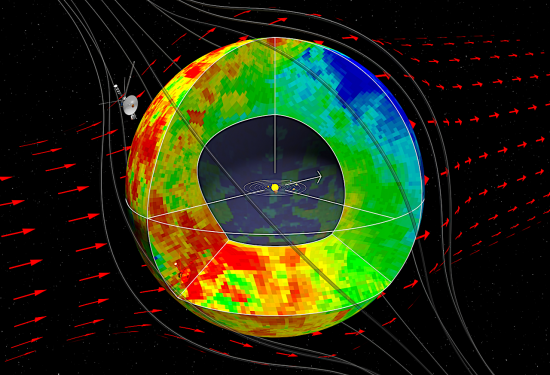
A new consensus model of the heliosphere. Note that there is no comet-like tail. Credit: Dialynas, et al.
March 13, 2018
The Solar System is encompassed by a globe of electromagnetism.
There is geometry in the humming of the strings, there is music in the spacing of the spheres.
— Pythagoras
It is estimated that there is one atom per cubic centimeter in interstellar space, while in the Milky Way’s galactic halo atoms are estimated to be ten centimeters apart. The regions of least density are in the intergalactic voids, where it is theorized that there is only one atom for every ten cubic meters.
The Interstellar Medium (ISM), through which the Solar System and all other star systems are moving, consists of gas and dust primarily composed of hydrogen and helium, with a small percentage of dust particles that are less than one-tenth of a micron in size. One micron is equal to one-millionth of a meter, so the dust is smaller than the frequency of blue light (0.450 microns).
Studies confirm that there is an unexpected cloud of gas and dust encompassing the Sun’s heliosheath (Solar System). Prior to the discovery, conventional understanding did not predict that it would be there because high pressure supernova shockwaves should have blown it away. The commonly held belief among astronomers was that the Solar System was “plowing through” the ISM, leaving a tadpole-like tail trailing behind.
One important characteristic of the ISM is that it contains ionized particles. It is those electrons and positive ions that are critical to understanding the behavior of the ISM and how the Solar System interacts with it. Although the ISM is extremely diffuse, if charge separation takes place in different regions, a weak electric field will develop. An electric field, no matter how weak, initiates an electric current.
On August 20, 1977, NASA launched the Voyager 2 mission on a multiyear journey to the outer Solar System. Voyager 1 was launched on a faster, shorter trajectory on September 5, 1977. Voyager 1 passed through the Sun’s termination shock in December 2004. Voyager 2, traveling a different path, did the same in August 2007.
When Voyager 1 experienced “unusual events” as it approached the boundary between the Sun and interstellar space, Electric Universe advocate Wal Thornhill explained that the spacecraft was entering a “double layer”, or Langmuir plasma sheath between the solar plasma and the plasmas of the ISM. Since there are magnetic fields strong enough to hold clouds of gas and dust together against the influence of hypothetical supernova explosions, then electric charge must be flowing through the ISM in order to create those fields.
According to a recent press release, the tadpole-tail model of the heliosheath is incorrect. In reality, there is a spherical “shell” of electromagnetism surrounding the Solar System. Kostas Dialynas at the Academy of Athens in Greece wrote:
“Instead of a prolonged, comet-like tail, this rough bubble-shape of the heliosphere is due to the strong interstellar magnetic field — much stronger than what was anticipated in the past — combined with the fact that the ratio between particle pressure and magnetic pressure inside the heliosheath is high.”
Although this is not the first time reading those statements, because the changes in the heliosphere are slow, new data had to wait for changes in the solar cycle to be reflected in conditions at the Sun’s electromagnetic boundary.
Electric Sun theory presupposes that the Sun is a positive terminal, or anode, in a complex interstellar circuit. The Sun’s negative pole, or cathode, is a field of charged particles surrounding the Sun’s electric discharge billions of kilometers away. Double layers at the heliosphere’s edge isolate the Sun’s plasma from the ISM.
A dark mode electric discharge radiates from the Sun in all directions. The solar wind travels outward to the edge of the Solar System at 700 kilometers per second, where it encounters the heliopause. Heat and pressure cannot explain how charged particles are accelerated as they pass by the planets on their way to the heliospheric cathode.
Electric currents generate magnetic fields. Voyager’s research team found magnetic fields strong enough to hold the boundary of the heliosphere together in a sphere. Electric charge must be flowing through the ISM in order to create that structure. This observation is an important confirmation of the Electric Sun theory.
Stephen Smith












